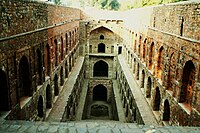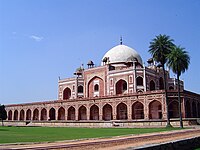History of Delhi
| Historical Region of North India Delhi | |||||||||
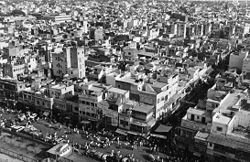 | |||||||||
| Established By | Anangpal Tomar (Founder of Delhi) | ||||||||
| Established in | 1052 CE | ||||||||
| Language | Hindustani (Hindi and Urdu), Punjabi, Bengali, English | ||||||||
| Wars | Battle of Delhi(1303) Mongols vs Khiljis Battle of Delhi(1556) Hemu vs Mughals Battle of Delhi(1737) Marathas vs Mughals Battle of Delhi(1753) Jats vs Mughals Battle of Delhi(1757) Marathas vs Mughals Battle of Delhi(1764) Jats vs Mughals Battle of Delhi(1771) Marathas vs Mughals Battle of Delhi(1783) Sikhs vs Mughals Battle of Delhi(1803) British East India Company vs Marathas Battle of Delhi(1804) British East India Company vs Marathas Battle of Delhi(1857) British East India Company Vs Mughals | ||||||||
| Dynasties | |||||||||
Delhi has a long history, and has been an important political centre of India as the capital of several empires.[1] Earliest coverage of Delhi's history is in the onset of the Tomar's kingdom in the 8th century. Since then, Delhi has been the centre of a succession of mighty empires and powerful kingdoms, making Delhi one of the longest-serving capitals and one of the oldest inhabited cities in the world. It is considered to be a city built, destroyed and rebuilt several times, as outsiders who successfully invaded the Indian Subcontinent would ransack the existing capital city in Delhi, and those who came to conquer and stay would be so impressed by the city's strategic location as to make it their capital and rebuild it in their own way.[2][3]
For 457 years (736 to 1193 AD), Delhi was ruled by the Tomar (or Tanwar) clan of rajput. It is the longest period for which any known dynasty has ruled over Delhi and surrounding areas. The Delhi Sultanate is the name given for a series of five successive dynasties, which remained as a dominant power of Indian subcontinent with Delhi as their capital.
During Sultanat period, the city became a center for culture.[4] The Delhi Sultanate came to an end in 1526, when Babur defeated the forces of the last sultan of Delhi, Ibrahim Lodi at the first Battle of Panipat, and formed the Mughal Empire.
The Mughals ruled the area for three centuries. During the 16th century, the city declined as the Mughal capital was shifted. The fifth Mughal Emperor Shah Jahan built the walled city of Shahjahanabad within Delhi, and its landmarks, the Red Fort and Jama Masjid.[5][6] His reign would be considered the zenith of the empire. After the death of his successor Aurangzeb, the Mughal Empire was plagued by a series of revolts. They lost major portions to the Marathas, Sikhs and many governors of erstwhile Mughal provinces like Bengal, Awadh and Hyderabad. The Jats captured major important cities of Mughal empire and surrounded Delhi from all sides. Delhi was sacked and looted by Nader Shah. The Marathas captured Delhi in the battle of Delhi in 1757 and continued to rule it until 1803[citation needed] when they were defeated by the British during the second Anglo-Maratha War. In 1803, the Delhi was captured by the British East India Company.
During Company Rule in India, the Mughal Emperor Bahadur Shah II was reduced to merely a figurehead. The Indian Rebellion of 1857 sought to end company rule and declared Bahadur Shah II the Emperor of India. However, the British soon recaptured Delhi and their other territories, ending the short-lived rebellion. This also marked the beginning of direct British Rule in India. In 1911, the capital of British India was shifted from Calcutta to New Delhi, the last inner city of Delhi designed by Edwin Lutyens.
After India's Independence from the British, New Delhi became the capital of the newly formed Republic of India.


Myths[]
References to Delhi's history in ancient literature are based on myths and legends. Ancient Indian texts state that the city of Delhi used to be referred to in Sanskrit as Indraprastha, which means "city of Lord Indra". The legendary ancient city of Indraprastha is believed to have been established 5000 years ago, as per the ancient Indian epic Mahabharata. A long-standing tradition associates Delhi with Indraprastha and identifies the legendary city with the village Indarpat, which survived until the early 20th century within the Purana Qila. There is no tangible archeological evidence, however, which links the excavated 'painted greyware' at Purana Qila with the Bharata Khanda site.[8]
Prehistory[]
There was Ochre Coloured Pottery culture in Red fort area which began around c.2000 BCE according to carbon dating. Around c.1200 BCE the region was inhabited by people of Painted Grey Ware culture which corresponds to Vedic Period.[9] Significant prehistoric sites in Delhi include Anangpur (in the Badarpur region), as well as Harappan excavations near Narela and Nand Nagari.[10]
Early Medieval India[]
Tomars[]

The bastion of Lal Kot fort in Delhi's Mehrauli built by Tomara ruler, Anangpal Tomar in c. 1052 CE.

Sculptures of ancient temple in Qutb Minar complex.
Anangpal Tomar founded Delhi in 1052. A VS 1383 inscription in Delhi Museum confirms the founding of Delhi by the Tomars.|[11]
He established the Tomar Dynasty of Delhi in the early 8th century and built his capital at the Anangpur village in Haryana. The Anangpur Dam was built during his reign; the Surajkund during the reign of his son Surajpal.[12]
Late Medieval period (13th-16th centuries CE)[]
Prithviraj Chauhan[]
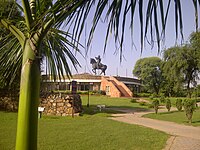
Museum and remnants of the walls of Lal Kot, the first city of Delhi.
The Rajput Chahamana (Chauhan) kings of Ajmer conquered Lal Kot in 1180 and renamed it Qila Rai Pithora. The Chauhan king Prithviraj III was defeated in 1192 by Muhammad Ghori in the Second Battle of Tarain, solidifying Muslim presence in northern India and shattering Rajput power in the Indo-Gangetic Plain.[13]

Delhi Sultanate[]
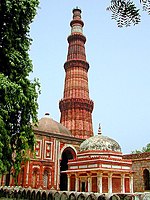
The Qutub Minar is the world's tallest brick minaret at 72.5 metres, built by Qutb-ud-din Aibak of the Slave dynasty in 1192 CE.[14]
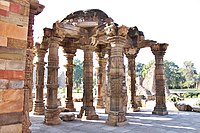
Mosque tomb over ancient temple structure in Qutb Minar complex
From 1206, Delhi became the capital of the Delhi Sultanate under the Slave Dynasty. The first Sultan of Delhi, Qutb-ud-din Aybak, was a former slave who rose through the ranks to become a general, a governor and then Sultan of Delhi. Qutb-ud-din started the construction of the Qutub Minar, a recognisable symbol of Delhi, to commemorate his victory but died before its completion. In the Qutb complex he also constructed the Quwwat-al-Islam (might of Islam), which is the earliest extant mosque in India.[15] He was said to have destroyed twenty-seven Jain temples initially housed in the Qutb complex and pillaged exquisitely carved pillars and building material from their debris for this mosque, many of which can still be seen.[16] After the end of the Slave dynasty, a succession of Turkic Central Asian and Afghan dynasties, the Khalji dynasty, the Tughluq dynasty, the Sayyid dynasty and the Lodi dynasty held power in the late medieval period and built a sequence of forts and townships in Delhi.[17][1]

Tomb of Ghiyasuddin Tughluq within the Tughlaqabad Fort.

Jahaz Mahal is built during the Lodi dynasty period (1452–1526) as a pleasure resort.
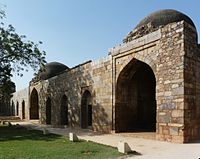
Alauddin Khilji's madrasa and Tomb in the Qutb complex.
Timur[]
In 1398, Timur Lang invaded India on the pretext that the Muslim sultans of Delhi were too tolerant of their Hindu subjects. After defeating the armies of Nasiruddin Mahmud of Tughlaq dynasty, on 15 December 1398, Timur entered Delhi on 18 December 1398, and the city was sacked, destroyed, and left in ruins, and over 100,000 war prisoners were killed as well.[18][19] In 1526, following the First Battle of Panipat, Zahiruddin Babur, the former ruler of Fergana, defeated the last Afghan Lodi sultan and founded the Mughal dynasty which ruled from Delhi, Agra and Lahore.
Early Modern period (16th-18th centuries CE)[]
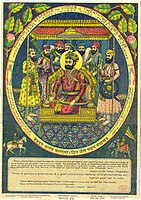
Hemu, Hem Chandra Vikramaditya, the Hindu emperor of North India who resisted Mughals in the 16th century.
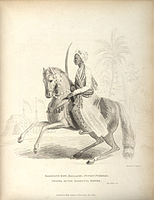
Raghunath Rao, the Maratha Peshwa who played a key role in capturing Delhi from the Afghans in the Second Battle of Delhi.
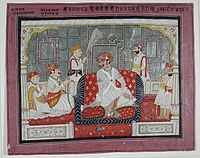
After losing the Battle of Delhi (1803) to the British, under Maratha ruler Daulat Rao Scindia, the Marathas lost control of Delhi and the right to collect chauth from the Mughals.
The early modern period in Indian history is marked with the rise of the Mughal Empire between the 16th and 18th centuries. After the fall of the Delhi Sultanate, the Mughals ruled from Agra, Sikri and Lahore, but the city once became the capital in 1648 during the rule of Shah Jahan, and remained the capital until the fall of the empire. During this time, Delhi became a center for culture, and poets such as Ghalib, Dard, Dagh and Zauq lived in the city and sought patronage of the emperor. The Mughals also built several monuments in the city including Humayun's Tomb, Red Fort, and Jama Masjid.
Babur and Humayun (1526–1556)[]
The first Mughal Emperors Babur and Humayun ruled from Agra, unlike the preceding Delhi Sultanate.
In the mid-16th century there was an interruption in the Mughal rule of India as Sher Shah Suri defeated Humayun and forced him to flee to Persia. Sher Shah Suri built the sixth city of Delhi, as well as the old fort known as Purana Qila, even though this city was settled since the ancient era. After Sher Shah Suri's death in 1545, his son Islam Shah took the reins of north India from Delhi. Islam Shah ruled from Delhi till 1553 when Hindu king Hemu, became the Prime Minister and Chief of Army of Adil Shah. Hemu fought and won 22 battles in all against rebels and twice against Akbar's army in Agra and Delhi, without losing any. After defeating Akbar's army on 7 October 1556 at Tughlaqabad fort area in Battle of Delhi (1556), Hemu acceded to Delhi throne and established Hindu Raj in North India for a brief period, and was bestowed with the title 'Vikramaditya', at his coronation in Purana Quila, Delhi. Hemu was defeated at the second battle of Panipat by Mughal forces led by Akbar's regent Bairam Khan, thus reinstating Mughal rule in the region.
Akbar to Aurangzeb (1556–1707)[]
The third and greatest Mughal emperor, Akbar, continued to ruled from Agra, resulting in a decline in the fortunes of Delhi. In the mid-17th century, the Mughal Emperor Shah Jahan (1628–1658) built the city that sometimes bears his name Shahjahanabad, the seventh city of Delhi that is more commonly known as the old city or old Delhi.[1][6] This city contains a number of significant architectural features, including the Red Fort (Lal Qila) and the Jama Masjid.[5] The old city served as the capital of the later Mughal Empire from 1638 onward, when Shah Jahan transferred the capital back from Agra.
Aurangzeb (1658–1707) crowned himself as emperor in Delhi in 1658 at the Shalimar garden ('Aizzabad-Bagh) with a second coronation in 1659. After 1680, the Mughal Empire's influence declined rapidly as the Hindu Maratha Empire rose to prominence.[20]
Decline of Mughals and rise of Marathas[]
The Mughal Empire suffered several blows due to invasions from Marathas, Jats, Afghans and Sikhs. In 1737, Bajirao I marched towards Delhi with a huge army. The Marathas defeated the Mughals in the First Battle of Delhi.[21][22] The Maratha forces sacked Delhi following their victory against the Mughals.[citation needed] In 1739, the Mughal Empire lost the huge Battle of Karnal in less than three hours against the numerically outnumbered but military superior Persian army led by Nader Shah during his invasion after which he completely sacked and looted Delhi, the Mughal capital, followed by massacre for 2 days, killing over 30,000 civilians and carrying away immense wealth including the Peacock Throne, the Daria-i-Noor, and Koh-i-Noor. Nader eventually agreed to leave the city and India after forcing the Mughal emperor Muhammad Shah I to beg him for mercy and granting him the keys of the city and the royal treasury.[23] A treaty signed in 1752 made Marathas the protector of the Mughal throne at Delhi.[24] In 1753 Jat ruler Suraj Mal attacked Delhi. He defeated Nawab of Delhi Ghazi-ud-din (second) and captured Delhi in the Capture of Delhi.[25] Jats sacked Delhi from 9 May to 4 June.[26] Ahmad Shah Durrani invaded North India for the fourth time in early 1757. He entered Delhi in January 1757 and kept the Mughal emperor under arrest. In August 1757, the Marathas once again attacked Delhi, decisively defeating Najib-ud-Daula and his Rohilla Afghan army in the Second Battle of Delhi.[27] Later, Ahmad Shah Durrani conquered Delhi in 1761, after the Third Battle of Panipat in which the Marathas were decisively defeated. Later, a treaty was made between the Marathas and Afghans that the Marathas would have all the lands east of the Sutlej river. Thus, the Marathas established full control over the city. Under the leadership of Jassa Singh Ahluwalia and Baghel Singh, Delhi was briefly conquered by the Sikh Empire in early 1783 in the Battle of Delhi (1783).[28]
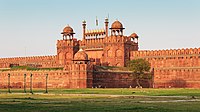
The Red Fort was commissioned by Mughal Emperor Shah Jahan in the 17th century,[5] it was the main residence of the Mughal emperors for nearly 200 years.
Humayun's Tomb is considered a predecessor to the Taj Mahal.[29]

The Jama Masjid is one of the largest mosques in India.

Safdarjung's Tomb was built in 1754 in the late Mughal architectural style for Nawab Safdarjung.
Colonial period (19th-20th centuries CE)[]
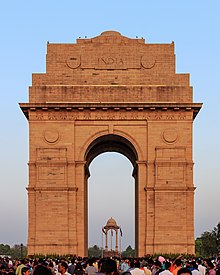

Company Rule[]
In 1803, during the Second Anglo-Maratha War, the forces of British East India Company defeated the Maratha forces in the Third Battle of Delhi, ending the Maratha rule over the city.[30] As a result, Delhi came under the control of British East India Company, and became a part of the North-Western Provinces. The Mughal Emperor Shah Alam II was a ruler only in name, and did not rule over any territory.
Revolt of 1857[]
The Indian Rebellion of 1857 sought to end Company Rule in India. On 11 May, the mutineers reached and captured Delhi, and declared Bahadur Shah II the Emperor of India, and the Emperor held his first court in many years. However, the British returned and laid siege to Delhi on 8 June 1857. On 21 September, Delhi had fallen to the British. The city received significant damage during the battle. Afterwards, the last titular Mughal Emperor Bahadur Shah Zafar II was captured and exiled to Rangoon.
Delhi passed into the direct control of British Government in 1857 after the Indian Rebellion of 1857 and the remaining Mughal territories were annexed as a part of British India.
British Raj[]
Calcutta was declared the capital of British India but in 1911 at the Delhi Durbar of 1911, held at the Coronation Park, King George V announced the shifting of the capital back to Delhi. Parts of the old city were New Delhi, a monumental new quarter of the city designed by the British architect Edwin Lutyens to house the government buildings was inaugurated in 1931 after its construction was delayed due to World War I.[1][31] The University of Delhi was also founded in 1922. New Delhi was officially declared as the seat of the Government of India after independence in 1947.
Post-Independence (1947–present)[]
After 1967 relations between Hindus and Muslims deteriorated to the level that there was a significant uptick in the number of riots and other disruption of civil life. One of the most significant was the 1973 riot in Bao Hindu Rao area, which resulted in the injury of 18 police officers and financial losses estimated to be around 500,000 Rupees, according to police sources. The riot was started after rumors spread that local Muslims wanted to change Bao Rao to a Muslim-only area. Another significant riot happened on 5 May 1974 in the Sadar Bazar area. A row started by a Hindu family and a couple of Muslims in a local cinema escalated into a clash between Hindus and Muslims in which 11 people were killed and 92 were injured. This riot was the worst in Delhi since independence. The Centre for the Study of Developing Societies carried out a survey in nearby areas that showed significant division between Hindus and Muslims who saw each other negatively.[32]
In 1966, an inscription of the Mauryan Emperor Ashoka (273-236 BCE) was discovered near Sriniwaspuri. Two sandstone pillars inscribed with the edicts of Ashoka were brought to by Firuz Shah Tughluq in the 14th century.

The Lotus Temple[33]

Delhi today.
The Raj Ghat, where Mahatma Gandhi was cremated.
See also[]
- Agrasen ki Baoli
- Gates of Delhi
- Mehrauli Archaeological Park
References[]
- ^ Jump up to: a b c d Centre, UNESCO World Heritage. "Delhi – A Heritage City". UNESCO World Heritage Centre. Archived from the original on 24 April 2018. Retrieved 11 December 2018.
- ^ "Archived copy". Archived from the original on 2 April 2015. Retrieved 10 June 2012.CS1 maint: archived copy as title (link)
- ^ "Delhi Tourism".
- ^ Hearn, The Seven Cities of Delhi 1906, pp. 88-99.
- ^ Jump up to: a b c Centre, UNESCO World Heritage. "Red Fort Complex". UNESCO World Heritage Centre. Archived from the original on 4 July 2018. Retrieved 11 December 2018.
- ^ Jump up to: a b Hearn, The Seven Cities of Delhi 1906, pp. 134-173.
- ^ Mittal, J.P. (2006), History of Ancient India (4250 BCE to 637 CE) page 675, ISBN 978-81-269-0616-1 (This author considers King Agrasen an actual historical figure)
- ^ Tillotson, Giles (2019). Delhi Darahan. Penguin Random House India. p. 6. ISBN 9780670091911.
- ^ Singh, Upinder (2008). A History of Ancient and Early Medieval India From the Stone Age to the 12th Century. ISBN 9788131711200.
- ^ Singh, Upinder (2006). Delhi: Ancient History. Berghahn Books. ISBN 9788187358299.
- ^ Cohen, Richard J. "An Early Attestation of the Toponym Ḍhillī". Journal of the American Oriental Society. 1989: 513–519.
- ^ Singh, Upinder (2006). Delhi: Ancient History. Berghahn Books. ISBN 978-81-87358-29-9.
- ^ "Rajasthan - History". Encyclopedia Britannica. Retrieved 17 September 2020.
- ^ Hearn, The Seven Cities of Delhi 1906, pp. 88-89.
- ^ Centre, UNESCO World Heritage. "Qutb Minar and its Monuments, Delhi". UNESCO World Heritage Centre. Retrieved 11 December 2018.
- ^ Jāvīd, ʻAlī (2008). World Heritage Monuments and Related Edifices in India. Pg.107. ISBN 9780875864846. Retrieved 27 May 2009.
- ^ Battuta's Travels: Delhi, capital of Muslim India Archived 23 April 2008 at the Wayback Machine
- ^ The Islamic World to 1600: The Mongol Invasions (The Timurid Empire) Archived 16 August 2009 at the Wayback Machine
- ^ Hunter, Sir William Wilson (1909). "The Indian Empire: Timur's invasion 1398". The Imperial Gazetteer of India. 2. p. 366.
- ^ Thomas, Amelia (2008). Rajasthan, Delhi, and Agra. Lonely Planet. ISBN 978-1-74104-690-8.
- ^ Advanced Study in the History of Modern India 1707-1813
- ^ History Modern India
- ^ Jagmohan (2005). Soul and Structure of Governance in India. ISBN 9788177648317. Retrieved 2 June 2014.
- ^ Gordon, Stewart (16 September 1993). The Marathas 1600–1818, Volume 2. Cambridge University Press, 1993. ISBN 978-0-521-26883-7.
- ^ The Army Quarterly and Defence Journal, Volume 114. West of England Press. 1984.
- ^ Bhattacherje, S. B. (1984). Encyclopaedia of Indian Events & Dates. New Dawn Press. p. 595. ISBN 978-1-932-70549-2.
- ^ The Pearson General Studies Manual 2009, Showick Thorpe Edgar Thorpe
- ^ Johal, Vikramdeep (21 September 2018). "1783 Sikh conquest to come alive in Delhi". Retrieved 25 August 2020.
- ^ Centre, UNESCO World Heritage. "Humayun's Tomb, Delhi". UNESCO World Heritage Centre. Archived from the original on 4 July 2018. Retrieved 11 December 2018.
- ^ Mayaram, Shail (2003). Against history, against state: counterperspectives from the margins Cultures of history. Columbia University Press, 2003. ISBN 978-0-231-12731-8.
- ^ A brief but fascinating account of the Indian contractors behind this constructed a Little Malice.
- ^ Krishna, Gopal (1985). "Communal Violence in India: A Study of Communal Disturbance in Delhi". Economic and Political Weekly. 20 (3): 117–131. JSTOR 4373987.
- ^ Centre, UNESCO World Heritage. "Bahá'í House of Worship at New Delhi". UNESCO World Heritage Centre. Archived from the original on 2 March 2018. Retrieved 11 December 2018.
Bibliography[]
- Kishore, Raghav (2016). "Planning, traffic and the city: railway development in colonial Delhi, c. 1899–1905". Urban History. 44 (2): 1–17. doi:10.1017/S0963926816000353.
- "History of Delhi District". The Imperial Gazetteer of India, Vol. 11. Oxford at Clarendon Press. 1909. p. 225.
- Kapoor, Pramod; Singh, Malvika; Mukherjee, Rudrangshu (2009). New Delhi: Making of a Capital. Lustre Press. ISBN 978-81-7436-574-3.
- Byron, Robert (1931). New Delhi. The Architectural Review, Westminster.
- Hartcourt, A., Assistant Commissioner Delhi (1873). The New guide to Delhi. Lahore, Victoria Press.
- Fanshawe, H. C. (1902). Delhi – Past and Present. London, J. Murray.
- Fraser, Lovat (1903). At Delhi (An account of the Delhi Durbar, 1903). Bombay : Times of India Press and Thacker.
- Bardiar, Nilendra. Urban, Cultural, Economic and Social Transformation: History of New Delhi (1947-65). New Delhi, Ruby Press & Co. Archived from the original on 15 April 2014.
- Hearn, Gordon Risley (1906). The Seven Cities of Delhi. W. Thacker & Co., London.
External links[]
- Delhi (1938), a documentary by BFI archives
- Scenes from Delhi (Silent film). University of Pennsylvania Museum of Archaeology and Anthropology Films. c. 1930. 18:16–23:27 minutes in.
- Land and Acquisition Act of 1894, under which the new city of Delhi was acquired
- The agreement of construction of new city of Delhi with original signatures of Herbert Baker and Edwin Luteyns
- History of Delhi
- New Delhi
